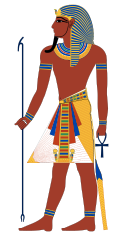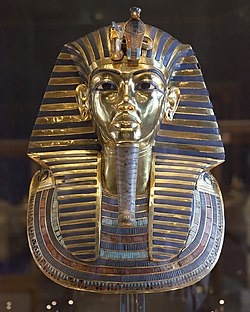| Nemes | |
|---|---|
 Nemes, symbolizing the Pharaoh’s power, both in life and death | |
| Details | |
| Country | Egypt |
| Material | Linen |
| ||||
| Nemes, striped head cloth (crown as determinative)
| ||||
|---|---|---|---|---|
| ||||
| Nemes in hieroglyphs | ||||
|---|---|---|---|---|
Nemes (/ˈnɛmɛʃ/) consisted of pieces of striped head cloth worn by pharaohs in ancient Egypt.[1] It covered the whole crown and behind of the head and nape of the neck (sometimes also extending a little way down the back) and had lappets, two large flaps which hung down behind the ears and in front of both shoulders.[2] It was sometimes combined with the double crown,[3] as it is on the statues of Ramesses II at Abu Simbel. The earliest depiction of the nemes, along with a uraeus, is the ivory label of Den from the 1st Dynasty. It is not a crown in itself, but still symbolizes the pharaoh's power.
Modern Recreations
[edit]The occult society "The Hermetic Order of the Golden Dawn" used headwear similar to ancient Egyptian nemes, which they spelled "nemyss", as part of their "traditional ceremonial garb".[4]
Gallery
[edit]-
modern drawing of a pharaoh with a nemes
-
The back and upper part of portrait statuette of pharaoh Amenemhat III, wearing a nemes, c. 1853 – c. 1805 BCE
-
The golden mask from the mummy of Tutankhamun wearing the nemes, c. 1323 BCE
-
Relief from the Sanctuary of Khonsu Temple depicting Rameses III wearing a nemes
-
Miniature metal nemes
-
CE 1st-century Roman emperor as pharaoh (Louvre)
Further reading
[edit]- Toby A. H. Wilkinson, Early Dynastic Egypt, Routledge 1999
- Bruce Graham Trigger, Ancient Egypt: A Social History, Cambridge University Press 1983
- Fragment of a basalt Egyptian-style statue of Ptolemy I
References
[edit]- ^ Kathryn A. Bard, Encyclopedia of the Archaeology of Ancient Egypt, Routledge 1999, p.412
- ^ Watson Early Mills, Roger Aubrey Bullard, Mercer Dictionary of the Bible, Mercer University Press 1990, p.679
- ^ Max Pol Fouchet, Rescued Treasures of Egypt, McGraw-Hill 1965, p.208
- ^ Cicero, Chic; Cicero, Sandra Tabatha (2019). Golden dawn magic : a complete guide to the high magical arts. Woodbury, MN: Llewellyn Publications. p. 188. ISBN 978-0-7387-5798-8. OCLC 1089884900.
External links
[edit] Media related to Nemes headcloth at Wikimedia Commons
Media related to Nemes headcloth at Wikimedia Commons















